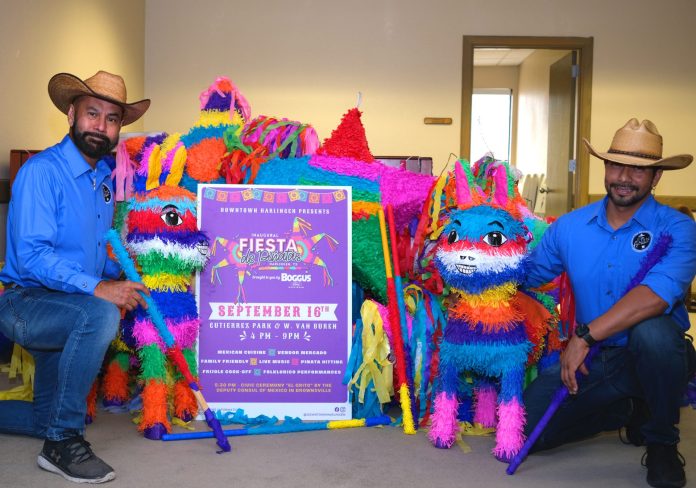
|
Only have a minute? Listen instead
Getting your Trinity Audio player ready...
|
HARLINGEN — La Placita’s streets are ready to burst into bright colors for Fiesta de Piñatas, Harlingen’s first festival commemorating Mexico’s independence from Spain.
The inaugural event was set to take off last year, running across downtown’s western streets, before a fast-moving thunderstorm forced its last-minute cancellation.
“So this is the first one,” Alexis Riojas, the Downtown Improvement District’s director, said of Saturday’s festival. “We’re more than ready. We’re ready to fiesta.”
After months of planning, the festival will commemorate Mexico’s independence from Spain, marking the Mexican holiday El Diez y Seis de Septiembre, while celebrating the culturally iconic piñata, whose artistry has become symbolic of Mexican-American culture.
Last year, Fred Uribe, co-owner of Don Gollito’s Restaurant, presented city officials with his concept of a piñata festival.
“It’s a celebration of the Hispanic Latino culture,” Uribe said in an interview. “Down here in Harlingen, we don’t celebrate the Hispanic culture. I think we lost the Hispanic culture in Harlingen.”
So he pitched his idea to Mayor Norma Sepulveda and city commissioners.
“I knew Fiesta de Piñatas was perfect the moment it was presented,” Sepulveda said in a statement. “It’s important to me that we create opportunities to celebrate our culture, and this event honors traditions while bringing families together to celebrate 16 de Septiembre with joy and a sense of community.”
While artists and chefs showcase their music and art along with salsas and dulces along West Van Buren Avenue from E Street to West Street, the festival’s Comida Market will feature fajita tacos, espiropapas, fruit cups, nachos and aguas frescas.
At Mercado Market, artists will display their hand-crafted ceramics and sterling silver jewelry along with leather handbags, shoes and hats.
Across West Van Buren Avenue from E Street to West Street, the festival will stage the music of Mariachis Estrelas del Valle, the Revo Live Band and headliner Amanda Solis and her Ultimate Selena Experience.
“We’re creating an event celebrating our culture,” Riojos said in an interview. “It’s an event for the family to come out and enjoy. A lot of people don’t know La Placita is part of downtown.”
For families, children will get their chances to burst piñatas filled with candies.
Then at 4 p.m., Fiesta de Piñatas comes alive at Gutierrez Park.
An hour later, the Mexican Consulate’s office will perform the traditional Grito, commemorating Father Miguel Hidalgo’s call, leading to the start of Mexico’s fight for Independence from Spain in 1810.
Running to 9 p.m., the festival turns the piñata into the life of the party, giving children chances to burst the brightly painted paper mache casks.
“Piñatas are very rich in the Hispanic culture — colorful, vibrant, fun, festive,” Riojas said. “They’re all uniquely different in their own way, with purples, blues, yellows, oranges — neon type colors.”
Since he was a child, piñatas captured Uribe’s fancy, leading him to delve into their historical, cultural and religious significance.
By some accounts, the piñata evolved in 14th Century Europe before the Spanish brought the tradition to Mexico and Latin America, where it merged with Aztec and Mayan traditions.
In Mexico, the Catholic tradition was associated with Lent, the piñata’s seven points symbolizing the seven deadly sins, while its candy represented temptation.
“The piñata brings the family together, the children together,” Uribe said. “It’s a figure that brings the family together. They dress up in festive colors — women in floral dresses with red flowers and men in their attire with charro hats. I wanted to see that in Harlingen.”



